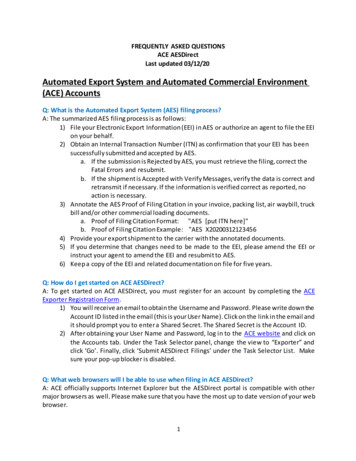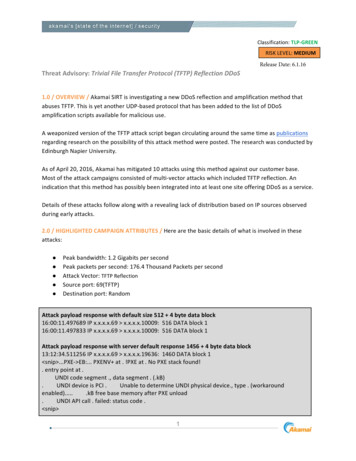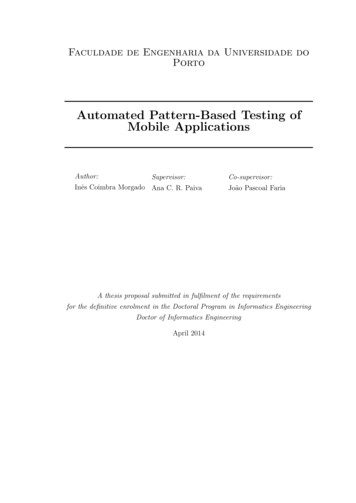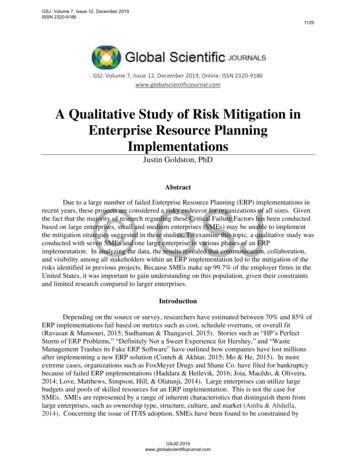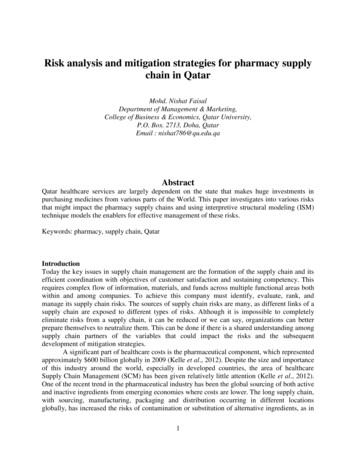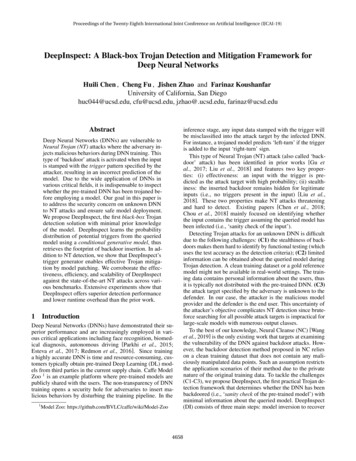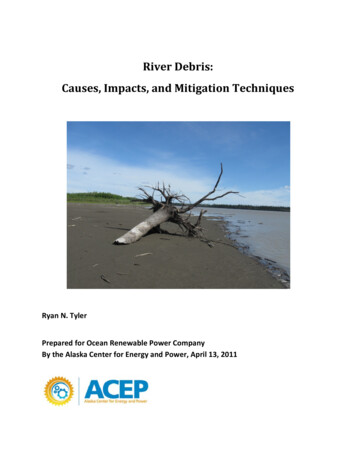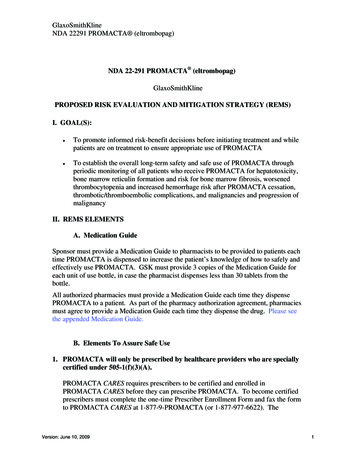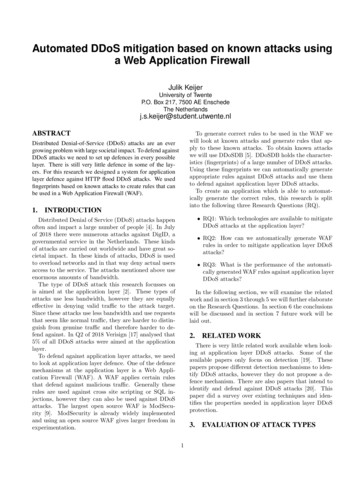
Transcription
Automated DDoS mitigation based on known attacks usinga Web Application FirewallJulik KeijerUniversity of TwenteP.O. Box 217, 7500 AE EnschedeThe Netherlandsj.s.keijer@student.utwente.nlABSTRACTTo generate correct rules to be used in the WAF wewill look at known attacks and generate rules that apply to these known attacks. To obtain known attackswe will use DDoSDB [5]. DDoSDB holds the characteristics (fingerprints) of a large number of DDoS attacks.Using these fingerprints we can automatically generateappropriate rules against DDoS attacks and use themto defend against application layer DDoS attacks.To create an application which is able to automatically generate the correct rules, this research is splitinto the following three Research Questions (RQ).Distributed Denial-of-Service (DDoS) attacks are an evergrowing problem with large societal impact. To defend againstDDoS attacks we need to set up defences in every possiblelayer. There is still very little defence in some of the layers. For this research we designed a system for applicationlayer defence against HTTP flood DDoS attacks. We usedfingerprints based on known attacks to create rules that canbe used in a Web Application Firewall (WAF).1.INTRODUCTION RQ1: Which technologies are available to mitigateDDoS attacks at the application layer?Distributed Denial of Service (DDoS) attacks happenoften and impact a large number of people [4]. In Julyof 2018 there were numerous attacks against DigID, agovernmental service in the Netherlands. These kindsof attacks are carried out worldwide and have great societal impact. In these kinds of attacks, DDoS is usedto overload networks and in that way deny actual usersaccess to the service. The attacks mentioned above useenormous amounts of bandwidth.The type of DDoS attack this research focusses onis aimed at the application layer [2]. These types ofattacks use less bandwidth, however they are equallyeffective in denying valid traffic to the attack target.Since these attacks use less bandwidth and use requeststhat seem like normal traffic, they are harder to distinguish from genuine traffic and therefore harder to defend against. In Q2 of 2018 Verisign [17] analysed that5% of all DDoS attacks were aimed at the applicationlayer.To defend against application layer attacks, we needto look at application layer defence. One of the defencemechanisms at the application layer is a Web Application Firewall (WAF). A WAF applies certain rulesthat defend against malicious traffic. Generally theserules are used against cross site scripting or SQL injections, however they can also be used against DDoSattacks. The largest open source WAF is ModSecurity [9]. ModSecurity is already widely implementedand using an open source WAF gives larger freedom inexperimentation. RQ2: How can we automatically generate WAFrules in order to mitigate application layer DDoSattacks? RQ3: What is the performance of the automatically generated WAF rules against application layerDDoS attacks?In the following section, we will examine the relatedwork and in section 3 through 5 we will further elaborateon the Research Questions. In section 6 the conclusionswill be discussed and in section 7 future work will belaid out.2.RELATED WORKThere is very little related work available when looking at application layer DDoS attacks. Some of theavailable papers only focus on detection [19]. Thesepapers propose different detection mechanisms to identify DDoS attacks, however they do not propose a defence mechanism. There are also papers that intend toidentify and defend against DDoS attacks [20]. Thispaper did a survey over existing techniques and identifies the properties needed in application layer DDoSprotection.3.1EVALUATION OF ATTACK TYPES
3.2To understand the possible defence at the applicationlayer, we must first asses the attack types at the application layer. For this research we look at the two majortypes of application level attacks:In a HTTP flood attack a large number of legitimateHTTP request is sent to the attack target. These requests are designed to cause as much strain on the attack target as possible while costing very little bandwidth. This makes it possible for the attack to be executed using only a few attackers. The attack is launchedusing either HTTP GET or POST. With a HTTP GETflood the requests are typically to load images and witha HTTP POST flood the requests often cause the serverto execute database queries that take a large amount oftime to execute.1. Low and Slow attacks;2. HTTP flood attacks.These attacks are much more sophisticated and precise than most transport layer attacks. Therefore theyare not detectable with traditional DDoS mitigationtools and a custom approach must be taken.In the following subsections we will discuss the attacktypes and the available mitigation strategies.3.13.2.1Low Orbital Ion CannonThe Low Orbit Ion Cannon (LOIC) [7] is a networkstressing tool suitable for executing HTTP flood attacks. It can be used from just one device, but it canalso be used in a large network to execute DDoS attacks.The LOIC has been used in large attacks responding tothe relinquished support of Wikileaks [16]. Since wehave to simulate a DDoS attack, we will use the LowOrbit Ion Cannon as a reference for a HTTP flood attack.Low and Slow attacksWe will discuss two types of Low and Slow attacks:1. Slowloris attacks;2. R-U-Dead-Yet attacks.3.1.1HTTP floodSlowloris3.2.2SolutionsIn a Slowloris attack the attacker tries to open asmany connections to the target as possible using HTTPGET requests. The attacker then keeps the connectionopen by slowly sending request header data to the target, without ever completing the request header. Oncethe attacker holds all connections it is impossible forvalid traffic to reach the server.The commercial solutions [6], [3] both indicate thattheir approach to blocking HTTP flood attack is usingtraffic analysis and IP reputation. In this academic survey [21] a wide range of solutions, among which IP reputation is presented as a good solution towards HTTPflood attacks.3.1.23.3R-U-Dead-YetTo answer the research question: ”Which technologiesare available to mitigate DDoS attacks at the application layer?” we find that it is difficult to defend againstapplication layer DDoS attacks. The fact that malicioustraffic is hard to distinguish from valid traffic makes itcomplicated for traditional defence mechanisms to defend against application layer attacks.When we examine signature based defences we observed that the most common method against application layer DDoS attacks is using IP reputation andtraffic analysis.In a R-U-Dead-Yet attack the attacker tries to keepthe server waiting using HTTP POST requests. Theattacker informs the target server that they are sending a large amount of data, but only does so very slowly.Therefore the attacker keeps the connection open. Whenthis is repeated multiple times all connections to thetarget server are taken up.3.1.3FindingsSolutionsThere are different commercial solutions available tomitigate Low and Slow attacks [14], [15]. Their solutions rely on reverse proxies, which means that theyroute all traffic via their own servers and only send complete requests to the target server. This means that theburden of the attack only falls upon the proxy servers,which are more capable to handle the attacks than normal servers.Among the academic solutions there are different approaches. One part of the solutions focuses on assessingthe validity of the packets using a trust score [22], whileother solutions rely on analysing web traffic using characteristics of different types of attacks xxxxxxxxxxTable 1: Literature examination2
4.MITIGATION STRATEGIESSecRule VARIABLES OPERATOR [ACTIONS]Where the VARIABLES can be used to define the parameters you want to evaluate, for example an IP address. The OPERATOR can be used to match against theVARIABLES, for example "@ipmatch 127.0.0.1". TheACTIONS describe what is to be done once the rule istriggered, for example deny the packet.Since ModSecurity handles the variables we can easilymatch against known malicious IP addresses. The mostsuitable way is to create an IP blacklist and let ModSecurity check against these IP addresses. The rule that isconstructed for that purpose is the following: SecRuleREMOTE ADDR "@ipMatchFromFile ip blacklist.txt"Where the REMOTE ADDR is the IP address of the attacker and ip blacklist.txt is a list of known malicious IP addresses.To generate WAF rules this research proposes to usethe fingerprints from DDoSDB [5]. DDoSDB is a largedatabase with known DDoS attacks. From these attacks fingerprints are constructed. DDosDB holds manytypes of DDoS attack, however there are currently noHTTP attacks in DDoSDB. Therefore we will createour own application layer attacks and create fingerprintsfrom those attacks to be used in rule creation.Even though there are currently no HTTP fingerprints available in DDoSDB, this research proposes todevelop WAF rules based on the DDoSDB fingerprints.Since such fingerprints might be available in the future.4.1Fingerprint analysisFirstly the available fingerprints from DDoSDB wereanalysed. Fingerprints are build up from the followingparameters of the DDoS attack:4.3When mitigating application layer attacks we will divide the attacks in the two types mentioned in section3. Low and Slow attacks and HTTP flood attacks.1. Protocol of the attack2. Start time of the attack4.3.13. Duration of the attack in secondsLow and SlowTo understand the mitigation of Low and Slow attacks there has to be understanding of the process ModSecurity goes through when analysing web-traffic [8].The phase in which the check against IP addresses isdone is phase 1. This phase is executed after the request headers have been parsed and before the requestbody is parsed. This is described in figure 1.4. Destination ports5. Source IP addresses6. Source portsIn the parameters the attacker is indicated as sourceand the attack target is indicated as destination.Since the destination port at which an applicationlayer attack is targeted is always 80 or 443. And sourceports can be chosen at random. We found that theparameter information that is most useful is the sourceIP.From the findings in section 3.3 we gathered that oneof the effective measures against application layer DDoSattacks is using IP reputation.4.2MitigationWAF rulesWe identified the Source IP as the best indicator fora DDoS attack based on the available fingerprint data.Therefore we looked at possible rule implementation ofWAF rules. As described in the introduction our chosenWAF is ModSecurity [9].ModSecurity is a module that can be installed inApache or Nginx. For the purpose of this research ModSecurity has been installed on an Apache Server [1].ModSecurity can be used to inspect every aspect of webtraffic and execute rules upon the traffic. As a standardrule set for ModSecurity the OWASP core rule set [10]has been designed. Apart from the core rule set it ispossible to design custom rules for ModSecurity, whichhas been done for the purpose of this research. A ModSecurity rule is constructed in the following way:Figure 1: ModSecurity phases [8]In a Low and Slow attack all request are stuck inthe SERVER BUSY READ/WRITE state, which is even before phase 1. A Slowloris attack abuses the READ stateby making the server wait for a READ request and aR-U-Dead-Yet attack abuses the WRITE state by making the server wait for a WRITE request. Therefore aLow and Slow attack cannot be detected using ModSecurity and the IP blacklist cannot be used. Thereare however countermeasures designed for ModSecurity3
and Apache. For ModSecurity there is the configuration SecConnReadStateLimit [12] and the configuration SecConnWriteStateLimit [13]. These configurations dictate how many open connections one IP address may have in either the READ and WRITE states.Using these configurations the effects of a Slowloris attack and a R-U-Dead-Yet attack can be mitigated. InApache the module mod reqtimeout [11] can be used tomitigate Low and Slow attacks. With this module it ispossible to give a maximum time to complete a requestheader or a request body. It is also possible to set aminimum speed for data transfer, this mitigates Lowand Slow attacks.4.3.2SecRule RESPONSE STATUS "Streq 404" "phase:5,id:1040log,msg:’Invalid page request’,setvar:ip.dos counter 1,expirevar:ip.dos counter 60"Rule 2:SecRule IP:DOS COUNTER "gt 10" "phase:1,id:’1041’,drop,log,msg:’Client Connection Dropped due to high # ofinvalid page request’"HTTP floodRule 1 evaluates the response Apache formulates tothe requests. In an attack where random pages are requested the server will respond with HTTP code 404,meaning that the page could not be found. This rulethen adds to the variable ip.dos counter and sets theexpiration time to 60 seconds. This means that everytime an IP address requests a page that does not existit will be registered and that information will be keptfor 60 seconds.Rule 2 evaluates if the variable ip.dos counter isgreater than 10. Meaning that there were more than10 request to pages that do not exist in the last 60seconds. When there is an IP address that matchesthat requirement all further requests, within those 60seconds, will be dropped.HTTP flood attacks rely on a long computation timeon the server. Therefore it is critical that the requestsare denied without the server spending much time perrequest. For this the IP blacklist is ideal. With a HTTPflood attack we evaluate the request in phase 1. Therewe can decide if a request is malicious and drop therequest without the server spending any more computation time. The following rule was used:SecRule REMOTE ADDR "@ipMatchFromFileip blacklist.txt" "phase:1,drop,nolog"This is the same rule as discussed in the subsectionWAF rules 4.2, with the actions drop and nolog. Dropindicates that the request is dropped without any further action and nolog indicates that there will be no logentry, if there is a log entry created per request thereis still the possibility that the server will become overloaded because of the log file size.4.44.5To answer the research question: ”How can we automatically generate WAF rules in order to mitigate application layer DDoS attacks?” we evaluated the differentattack types and their mitigation strategies.When evaluating the mitigation of Low and Slow attacks we found that the attack occurs before ModSecurity rules are triggered. Therefore we find that itis not possible to use ModSecurity rules, based on fingerprints to mitigate these attacks. However there aremethods available within ModSecurity and Apache tomitigate these attacks which are not present in the corerule set of ModSecurity and are therefore not widely implemented. When evaluating the mitigation of HTTPflood attacks we find that using the parameters availablefrom DDoSDB and the rules available within ModSecurity we can construct an IP blacklist against which theincoming traffic can be checked. When looking at mitigation strategies outside of the fingerprint informationa mitigation method using traffic analysis was found.Mitigation outside of fingerprintsWhen looking outside of the fingerprint informationit is possible to identify characteristics of a HTTP floodattack, which can be used to mitigate the attack. Whenevaluating the attack options of the LOIC as pictured infigure 2 we see that the option append random charsto the URL is present. This option makes it possible torequest random pages or make random requests. Thisoption makes it harder to defend against, since requestsseem legitimate. The requests that results from thisoption can be seen in figure 3, there the random requestsis as follows: GET /GIMGPV.ModSecurity offers different tools to use this information in the mitigation. With ModSecurity it is possible to assign variables to an IP address. This makesit possible to ban IP addresses that perform suspiciousactions.4.4.1FindingsUsing IP variables5.The following rules have been identified to mitigatethe aspect of requesting random pages using the LOIC:Rule 1:MITIGATION PERFORMANCEFrom the findings in section 4.5 we have gatheredthat it is not possible to use automatically generated4
WAF rules against Low and Slow attacks. Thereforewe will focus on HTTP flood attacks when evaluatingthe performance.5.1tocol similar to HTTP. From the 45 attack fingerprintsfound for this protocol we extracted over 1.2 million IPaddresses for our blacklist. Based on the fingerprint intable 3 we added the IP:127.0.0.1 to the IP blacklist.Attack5.2.1We will use the Low Orbit Ion Cannon (LOIC) as theattack tool to execute a HTTP flood attack as picturedin figure 2. In this test set-up the Apache server isrunning on the same device from which the attack isbeing launched. Therefore the attack destination is setas IP:127.0.0.1 with PORT:80.PerformanceTo test the performance of the ModSecurity rule withthe IP blacklist we sent a single request to the ApacheServer. Which resulted in the following:Phase1:header processing5:loggingTotalComputation timein microseconds509149659Table 3: IP blacklist performanceTable 3 indicates that the computation for our ruleonly takes half a millisecond per request. Which meansthat the server can handle at least one thousand requests per second for an IP blacklist this size.Figure 2: Low Orbit Ion CannonIn the test set-up the LOIC generates random HTTPGET requests for the target server to fetch, which aredepicted in figure 3.5.2.2Using the IP Blacklist we were able to block 100 percent of the malicious traffic, since the IP address of theattacker was known.5.3Since these are valid HTTP GET request it difficultto identify them as malicious traffic.To test our ModSecurity rules we constructed the following fingerprint based on this attack.5.4Value”HTTP””2019-01-16 14:25:51”[80]48.475940227508545[{ip: ”127.0.0.1”}][56170]FindingsTo answer the research question: ”What is the performance of the automatically generated WAF rules againstapplication layer DDoS attacks?” we find that we wereable to mitigate 100 percent of a HTTP flood attackusing the fingerprint of that attack. We were able toautomatically add the parameters of this fingerprint toan IP blacklist which was used to mitigate an HTTPflood attack. We demonstrated the mitigation usingattack launched by the LOIC.We find that using the rules for traffic analysis a mitigation of over 99 percent can be achieved.Table 2: HTTP flood fingerprint5.2Traffic analysis defenceWe added the rules specified in section 4.4.1 to therule set. Since the attack was coming from one IP address almost the entire attack was mitigated. The first10 requests were needed to trigger the second rule. After which all packets were dropped. In an attack wherea large number of requests per second are sent the first10 requests are trivial. Which means that using thismitigation strategy a block percentage of over 99 percent can be achieved.Figure 3: LOIC network packetParameterprotocolstart timedst portsduration secsrc ipssrc portsBlockingIP blacklist defenceWe implemented the rule which was identified in section 4.3.2 to mitigate HTTP flood. The rule is dependant on the IP blacklist.To have a representative IP blacklist we added all IPaddresses from DDosDB from the QUIC protocol. A pro-6.CONLUSIONSIn this research we analysed different application layerattacks and their defences. In section 3 we reviewed5
application level DDoS attacks and their possible mitigation strategies. In that section we concluded thatmitigations using IP reputation and traffic analysis aremost implemented. In section 4 we proposed a mitigation strategy for HTTP flood attacks. We created afingerprint for the HTTP flood attack and used that fingerprint to create a WAF rule to mitigate the attack. Insection 5 we implemented the rule in ModSecurity andshow
A WAF applies certain rules that defend against malicious tra c. Generally these rules are used against cross site scripting or SQL in-jections, however they can also be used against DDoS attacks. The largest open source WAF is ModSecu-rity [9]. ModSecurity is already widely implemented and using an

